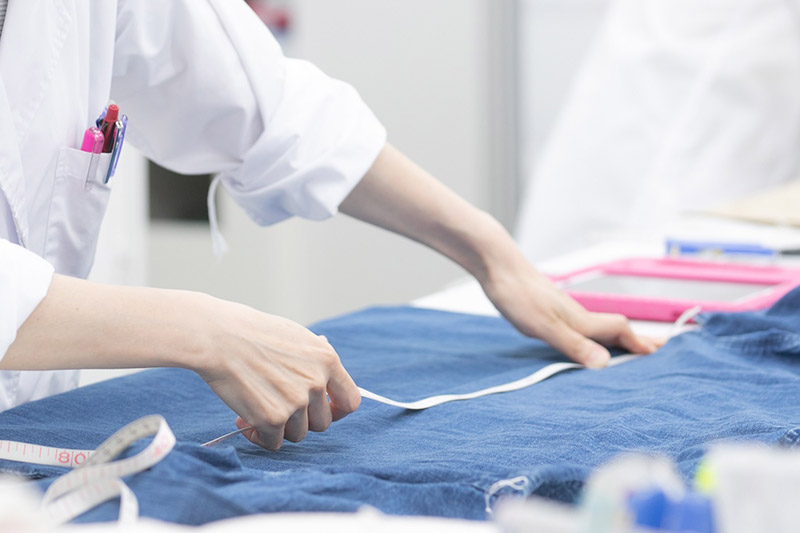Garment inspection
Garment inspection is a critical component of quality assurance in the textile and apparel industry. It involves detailed examination to ensure that garments meet specified standards for fit, finish, durability, and compliance with international regulations. This service plays a pivotal role in maintaining brand reputation, customer satisfaction, and regulatory adherence.
The process begins with thorough visual inspection, where trained professionals examine fabric quality, stitch integrity, color consistency, and overall appearance. Following this, garment inspection may include mechanical tests to assess the strength of seams and stress points. Advanced techniques such as ultrasonic testing or specialized dye fastness checks are employed for more stringent standards.
Environmental factors like temperature, humidity, and lighting conditions during inspection can significantly impact results. Therefore, controlled environments are maintained to ensure accurate assessments. Compliance with international standards such as ISO 17635:2019 (Garments—Test methods for the identification of certain chemical substances) ensures that inspections are conducted consistently across different markets.
For manufacturers, garment inspection helps in reducing rejections during final stages of production and minimizes waste by identifying issues early. It also aids in meeting customer expectations regarding fit, comfort, and style. From a compliance officer's perspective, it guarantees adherence to environmental regulations concerning fabric dyeing processes and chemical use.
In the realm of research and development (R&D), garment inspection provides invaluable data for improving product design and functionality. By identifying shortcomings at various stages of production, R&D teams can innovate more sustainable materials and manufacturing methods. This not only enhances product quality but also contributes positively to environmental sustainability efforts within the industry.
Procurement departments benefit from comprehensive garment inspections by ensuring they source high-quality raw materials that meet required specifications. Properly conducted inspections reduce procurement risks associated with inferior products, thereby enhancing supply chain efficiency and reliability.
Benefits
Garment inspection offers numerous benefits to various stakeholders involved in the textile and apparel sector:
- Enhanced Quality Standards: Ensures that all garments produced meet strict quality criteria, leading to higher customer satisfaction.
- Improved Compliance: Helps manufacturers comply with international standards and regulations regarding fabric composition and processing methods.
- Cost Efficiency: Identifying defects early in the production process reduces costs associated with rework or scrap.
- Innovation Opportunities: Provides insights into areas where improvements can be made, fostering innovation within both R&D teams and procurement departments.
By integrating garment inspection into their operations, businesses can build stronger relationships with customers while also enhancing their own internal processes. This holistic approach ensures long-term success in an increasingly competitive market environment.
Environmental and Sustainability Contributions
- Reduced Waste: By identifying defects early in the production process, garment inspection helps minimize waste from rejections or scrapping of non-conforming products.
- Sustainable Materials: Inspection data can guide R&D teams towards developing more sustainable materials that are less harmful to the environment during manufacturing and disposal stages.
- Eco-Friendly Processes: Identifying issues related to fabric dyeing or chemical usage allows for the implementation of greener processing methods, reducing environmental impact.
- Energy Efficiency: Through continuous improvement initiatives based on inspection results, businesses can optimize energy consumption throughout their supply chains.
Garment inspection thus serves as a crucial link between quality assurance and sustainability practices within the textile industry. Its role extends beyond mere compliance to becoming an integral part of creating more responsible business models that contribute positively towards global environmental goals.
Competitive Advantage and Market Impact
In today’s highly competitive market, maintaining high standards in garment inspection is not just a best practice but also essential for staying ahead of competitors. Brands that invest in robust quality control systems gain significant advantages over their peers:
- Better Reputation: Consistently delivering top-notch products enhances brand reputation and loyalty among consumers.
- Innovation Leadership: Continuous improvement through inspection data enables companies to stay at the forefront of industry trends, offering unique features that differentiate them from others.
- Customer Satisfaction: Meeting or exceeding customer expectations ensures repeat business and favorable word-of-mouth recommendations.
The market impact of effective garment inspections extends far beyond individual businesses. It fosters a culture of excellence across the entire industry, driving innovation and sustainability efforts that benefit society as a whole. As consumers become more environmentally conscious, brands with strong inspection protocols are better positioned to meet these evolving demands.





